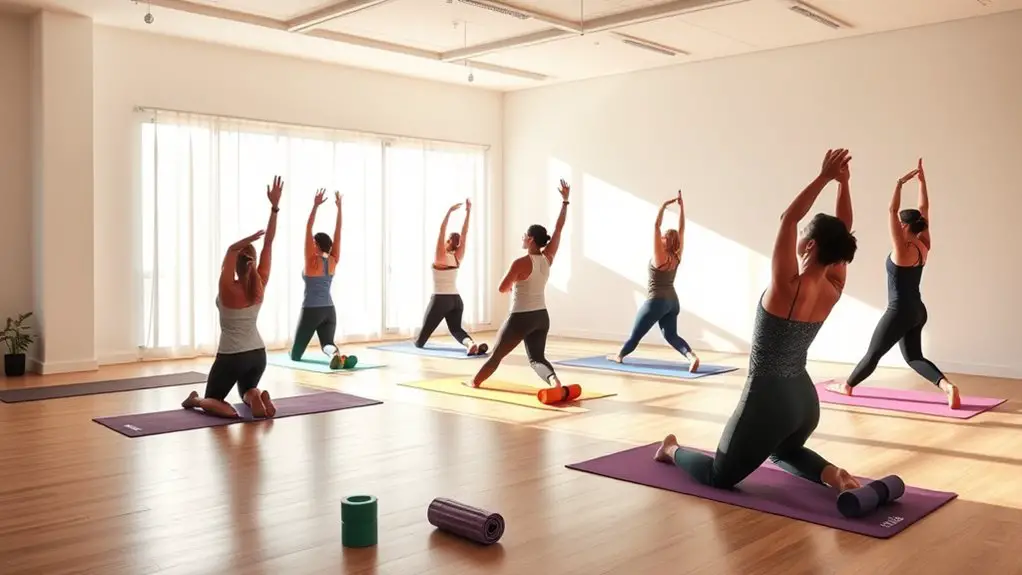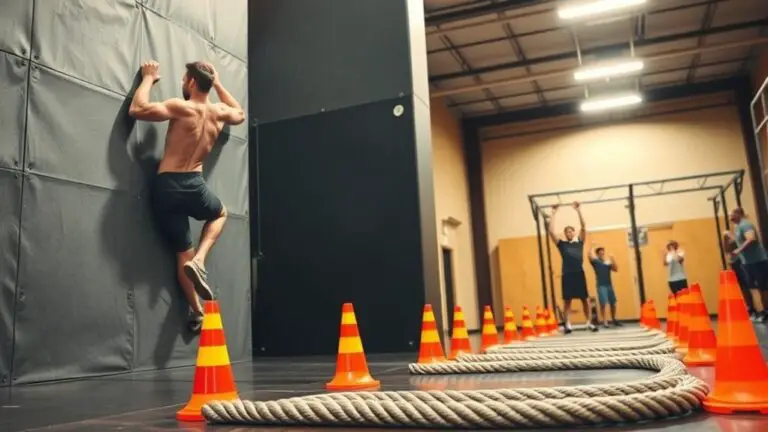Best Gym Workouts for Lower Back Pain Relief

To relieve lower back pain, focus on strengthening your core with exercises like planks and pelvic tilts. Incorporate stretching to improve flexibility and reduce tightness, choosing gentle moves like the child’s pose. Low-impact cardio activities, like walking or cycling, enhance overall fitness without straining your back. Additionally, resistance training with exercises on a stability ball can further support your spine. Stick around to discover more tips for a well-rounded workout routine tailored for back health.
Understanding Lower Back Pain: Causes and Symptoms

When you experience lower back pain, it can be challenging to pinpoint the exact cause, as various factors contribute to this common issue. One significant factor is muscle strain, which often occurs from lifting heavy objects improperly or overexerting yourself during physical activities. This strain can lead to chronic pain that persists long after the initial injury. Other causes may include poor posture, sedentary lifestyles, or even stress, which can cause muscle tension in the back.
You might also notice symptoms like stiffness, discomfort while sitting or standing, and difficulty in bending or twisting. Recognizing these signs early can help you make informed decisions about seeking medical attention or adjusting your daily routine. Prioritizing safety and understanding the root causes of your pain is essential for effective relief and preventing further injuries. Remember, addressing these issues promptly can lead to better long-term outcomes.
Importance of Strengthening Core Muscles
Strengthening your core muscles is essential for alleviating lower back pain, as a strong core provides stability and support to your spine. When you focus on building core stability, you help distribute weight evenly across your body, reducing strain on your lower back. This stability is key in maintaining proper posture during daily activities, which can prevent further injury.
Additionally, core endurance plays an important role in supporting your back over time. By improving your endurance, you can engage your core muscles longer without fatigue, which is critical during physical activities. Engaging in exercises like planks, bridges, and pelvic tilts can effectively strengthen these muscles.
Always remember to start slowly and make sure you use proper form to avoid injury. With consistent effort, you’ll notice improvements in your core strength, leading to better support for your lower back and overall enhanced well-being.
Stretching Exercises for Lower Back Relief

To effectively alleviate lower back pain, incorporating stretching exercises into your routine can greatly enhance flexibility and reduce muscle tension. Start with dynamic stretching, which warms up your muscles and prepares them for movement. Simple movements like hip circles and leg swings can engage your lower back and improve circulation.
After your workout, focus on static stretching to promote relaxation and elongation of the muscles. Gentle stretches like the child’s pose or seated forward bend can help relieve tightness in your lower back. Hold each stretch for about 20-30 seconds, breathing deeply to encourage relaxation.
Always listen to your body and avoid any movements that cause pain. If you’re unsure about any stretch, consult a fitness professional to guarantee you’re practicing safely. By incorporating these stretching techniques into your routine, you’ll not only find relief but also build a stronger foundation for your overall back health.
Low-Impact Cardio for Back Health
Incorporating low-impact cardio into your routine can greatly benefit your back health while minimizing strain. Activities like walking, cycling, and swimming are excellent choices. These aerobic activities improve blood circulation and boost overall fitness without putting excessive pressure on your spine.
Water aerobics, in particular, is a fantastic option. The buoyancy of water supports your body, reducing impact on your joints and back. You can engage in various movements, from gentle leg lifts to arm exercises, all while staying safe and comfortable.
Aim for at least 150 minutes of low-impact cardio each week, spread over several days. Start slowly, listen to your body, and adjust the intensity as necessary. Remember, the goal is to enhance your cardiovascular health while protecting your back. By prioritizing these activities, you’ll promote long-term back health and overall well-being.
Resistance Training: Key Exercises for Support

When it comes to relieving lower back pain, resistance training can be a game changer. By focusing on strengthening your core muscles and improving flexibility, you’ll build a solid foundation for better support. Let’s explore some key exercises that can help you achieve these important goals.
Strengthening Core Muscles
Although many people overlook core strength, it plays an essential role in alleviating lower back pain. Strengthening your core can provide stability and support, reducing strain on your back. Incorporate exercises like plank variations and pelvic tilts into your routine for effective results. These exercises not only build strength but also enhance your posture.
Here’s a simple table to get you started:
| Exercise | Description | Reps/Sets |
|---|---|---|
| Plank Variations | Hold a plank position, varying arms or legs | 3 sets of 30 seconds |
| Pelvic Tilts | Lie on your back, tilt pelvis upwards | 3 sets of 10-15 reps |
| Side Plank | Balance on one side, holding position | 3 sets of 20 seconds |
Engage in these exercises safely, focusing on form over quantity.
Improving Flexibility and Mobility
Improving flexibility and mobility is essential for alleviating lower back pain, as it helps maintain a healthy range of motion and reduces stiffness. Incorporating dynamic stretching before workouts can warm up your muscles and prepare your body for movement. Focus on gentle movements, like leg swings and arm circles, to enhance flexibility safely. After your workout, include mobility drills, such as hip openers and cat-cow stretches, to promote recovery and prevent tightness. Remember to listen to your body and avoid pushing into pain. Regularly practicing these techniques can improve your overall mobility, making daily activities easier and helping to support your lower back. You’ll feel more comfortable and confident in your movements.
Incorporating Stability Ball Workouts
To alleviate lower back pain effectively, incorporating stability ball workouts into your routine can be a game changer. Stability balls provide excellent support and help improve your core strength, which is essential for back health. By engaging in stability ball exercises, you can enhance your balance and stability while promoting proper posture.
Start with simple moves like ball squats or seated marches to integrate these exercises safely. Remember to keep your core engaged and your movements controlled. As you gain confidence, you can progress to more challenging exercises, such as ball passes or wall squats with the ball.
The stability ball benefits go beyond pain relief; they also help prevent future injuries by strengthening your back and abdominal muscles. Always listen to your body, and consult a professional if you’re unsure about any movements. Your journey toward a healthier back can begin with just a stability ball!
Yoga Poses for Back Strength and Flexibility
Incorporating a few key yoga poses into your routine can greatly enhance both back strength and flexibility. The yoga benefits extend beyond just physical improvements; you’ll also experience mental relaxation. Here are some effective pose variations to take into account:
| Pose | Benefits |
|---|---|
| Cat-Cow Stretch | Improves spinal flexibility |
| Downward Dog | Strengthens the entire back |
| Child’s Pose | Relaxes lower back muscles |
| Sphinx Pose | Builds strength in the lower back |
Start with gentle stretches and gradually increase intensity based on your comfort level. Always listen to your body and modify poses as needed to guarantee safety. Incorporating these yoga poses can be a safe and effective way to build strength and flexibility in your back while promoting overall well-being. Additionally, practicing yoga can help improve joint stability and enhance your overall physical health. Enjoy the process and embrace the journey toward a stronger back!
Tips for Proper Form and Technique
While engaging in gym workouts for lower back pain relief, maintaining proper form and technique is essential to avoid exacerbating your discomfort. Start by ensuring you have proper posture; keep your back straight and shoulders back. This alignment helps distribute weight evenly, reducing strain on your lower back.
When performing exercises, focus on mindful movement. Avoid jerky or rapid motions, as they can lead to injury. Instead, control your movements and breathe steadily throughout each repetition. If you’re lifting weights, choose a manageable weight to maintain form, and consider using a mirror to check your posture.
Additionally, engage your core during all exercises to provide extra support for your back. Don’t hesitate to ask a trainer for guidance or feedback on your technique. Taking these precautions will not only enhance your workout experience but also contribute to your recovery and overall back health.
Creating a Balanced Workout Routine
When it comes to relieving lower back pain, creating a balanced workout routine is essential. You’ll want to focus on core strength exercises to support your spine, along with flexibility and stretching to enhance your overall mobility. By incorporating these elements, you can help prevent discomfort and promote a healthier back.
Core Strength Exercises
To effectively relieve lower back pain, you can’t overlook the importance of core strength exercises in your workout routine. A strong core supports your spine and helps prevent further injury. Start with plank variations, such as side planks and forearm planks, to engage multiple muscle groups safely. Remember to maintain proper form—keep your body in a straight line and avoid sagging your hips. Additionally, incorporate pelvic tilts into your regimen. They’re simple yet effective for strengthening your lower back and abdominal muscles. Perform these tilts by lying on your back, bending your knees, and gently flattening your lower back against the floor. Consistently practicing these exercises can enhance your core strength, providing the stability your back needs for pain relief.
Flexibility and Stretching
Building a strong core is just one part of a thorough approach to managing lower back pain; flexibility and stretching are equally important. Incorporating dynamic stretching into your routine can help improve your range of motion and prevent injuries. Before starting your workout, consider gentle movements like leg swings or arm circles to warm up your muscles safely.
Foam rolling is another excellent tool for enhancing flexibility. It helps release tension in your muscles, making it easier to stretch effectively. Focus on rolling out your lower back, glutes, and hamstrings to alleviate discomfort. Always listen to your body; if something feels painful, ease off. By prioritizing flexibility and stretching, you’ll create a balanced workout routine that supports your lower back health.
Frequently Asked Questions
Can I Still Exercise With Severe Lower Back Pain?
Imagine your body as a delicate instrument, needing careful tuning. If you’ve got severe lower back pain, it’s essential to approach exercise with caution. You can still engage in pain management through gentle movements, but modifications are key. Opt for low-impact activities that don’t strain your back, like walking or swimming. Always listen to your body; if something feels wrong, stop. Prioritize safety and consult a healthcare professional before starting anything new.
How Long Should I Rest Before Returning to Workouts?
When considering how long you should rest before returning to workouts, it’s vital to listen to your body. Typically, resting for a few days to a week can help with pain management. If you still feel discomfort after that, you might need to extend your rest duration. Always prioritize your safety—consulting a healthcare professional can provide personalized guidance to guarantee you’re ready to safely resume your fitness routine.
Are There Any Specific Gym Machines to Avoid?
When considering gym machines, it’s essential to avoid those that may strain your back, like leg press and certain cable machines. Instead, prioritize exercise modifications that offer support and reduce the risk of injury. Focus on equipment that promotes proper form, like stationary bikes or resistance bands. Remember, pain management is key; listen to your body and consult a professional if something doesn’t feel right. Your safety should always come first!
Is It Safe to Lift Weights if I Have Back Pain?
Is it wise to lift weights when your back’s acting up? While weight lifting can be beneficial for pain management, safety’s your top priority. If you’re experiencing back pain, it’s essential to listen to your body. Consider starting with lighter weights and focusing on form. Always consult a healthcare professional before diving into a routine. Remember, pushing through pain isn’t strength; it’s a recipe for injury. Prioritize healing first!
How Often Should I Do These Workouts for Best Results?
You should aim to do these workouts about two to three times a week for the best results. This frequency allows your body to adapt while giving it enough time to recover between sessions. Incorporating recovery strategies, like stretching and rest days, is essential to prevent further strain. Listen to your body; if you feel discomfort, consider adjusting the frequency or intensity to guarantee you’re exercising safely and effectively.





